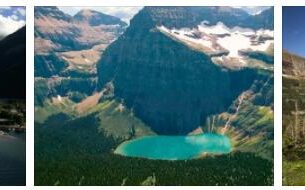Miguasha Paleontological Park (World Heritage)
The national park in the province of Québec is the world’s most important fossil site for the Devonian. The 370 million year old formation contains thousands of fossils, including important finds from the time when land vertebrates evolved from marine animals. One of the most famous finds is the fossil of a Eusthenopteron, a meat fin fish with gills, lung bladder and fin skeleton.
Miguasha Paleontological Park: facts
| Official title: | Miguasha Paleontological Park |
| Natural monument: | Paleontological park on the south coast of the Gaspésie peninsula, discovered in 1842; Site of five of the six fossil fish groups from the Devonian (360 to 290 million years ago), the “Age of Fish”; including the site of the Eusthenopteron foordi (first fish with evidence of adaptation to life on land) |
| Continent: | America |
| Country: | Canada |
| Location: | South coast of Quebec’s Gaspé Peninsula |
| Appointment: | 1999 |
| Meaning: | Worldwide unique quality of fish fossils from the Devonian; extraordinary documentation of evolution |
Rideau Canal (World Heritage)
The Rideau Canal is the oldest waterway system in North America. Starting in 1826, it was created for the British military within five years. The 202 km long canal stretches from Ottawa in the north to Kingston on Lake Ontario in the south.
Rideau Canal: Facts
| Official title: | Rideau Canal |
| Cultural monument: | 202 km long canal connecting Ottawa with Kingston on Lake Ontario; 1828-1832 by damming the Rideau and Cataraqui rivers built and still in use today with 49 locks as one of the first canals for steamships; originally built by the British for military purposes (including some fortifications) in conflict with the USA, but largely used for civilian settlement; from 1827 establishment of a city on the canal by the English engineer John By (Bytown, renamed Ottawa from 1854) |
| Continent: | America |
| Country: | Canada |
| Location: | Ottawa, Kingston |
| Appointment: | 2007 |
| Meaning: | The only canal from the great era of North American canal construction that has been preserved and used to this day; impressive example of a backwater canal and the use of European technology in the development of North America; material testimony to the historical disputes and military conflicts over North America |
Joggins fossil site (World Heritage)
The Joggins fossil site is in the province of Nova Scotia. With its 350 million year old carbon fossils, it allows unique insights into geological development. Petrified tree trunks, reptiles and amniotes were found.
Joggins Fossil Site: Facts
| Official title: | Joggins fossil site |
| Natural monument: | 15 km paleontological site along the cliffs of the Bay of Fundy on the peninsula of Nova Scotia in eastern Canada; on the coast on approx. 7 km² extensive fossils of reptiles and rainforest vegetation from the Carboniferous Age (359 to 299 million years ago); for the period of the Pennsylvania (Upper Carboniferous, 318 to 299 million years ago) most extensive fossil finds of life on land worldwide; developed in the middle of the 19th century, in 1851 discovery of a fossilization of the first pure reptile (Hylonomus lyelli), a forerunner of the dinosaur 100 million years later; Use of the findings by Charles Darwin for the development of the theory of evolution; three ecosystems (estuary system, rainforest floodplain, alluvial plain) with 96 genera and 148 species of fossils |
| Continent: | America |
| Country: | Canada, see topb2bwebsites |
| Location: | Nova Scotia Province, Eastern Canada |
| Appointment: | 2008 |
| Meaning: | Unique testimony to the history of the earth and invaluable material for researching geological and evolutionary developments; well-preserved and most extensive fossil documentation of life in the countryside in the Carboniferous; The fossils of the first reptiles from prehistoric times |
Old Québec (World Heritage)
The former capital of New France was founded in 1608 by Samuel de Champlain and has an excellently preserved historic city center from colonial times.
Old Quebec City: Facts
| Official title: | Historic area of Québec |
| Cultural monument: | Old town, including the Citadel, Sanctuaire Notre Dame du Sacré Coeur, the Maison Sewell, Convent des Ursulines, the Anglican Cathedral of the Holy Trinity, which was built on the model of London’s Saint Martin in the Fields church, the Place Royale, the Basilique -Cathédale Notre Dame de Québec and the Hôtel Dieu de Québec, formerly the Augustinian convent |
| Continent: | America |
| Country: | Canada |
| Location: | Québec, northeast of Montréal |
| Appointment: | 1985 |
| Meaning: | The former capital of Nouvelle-France as one of the outstanding examples of a fortified colonial city |
Old Quebec City: History
| 1608 | Foundation of the city |
| 1620 | Construction of the Fort Saint-Louis |
| 1635 | Death of the city’s founder, Samuel de Champlain |
| 1639 | Founding of the Convent des Ursulines and the Hôtel-Dieu de Québec |
| 1688 | Construction of the first Eglise Notre Dame des Victoires |
| 1690 | unsuccessful English attack on Québec |
| 1691 | Installation of the battery royale |
| 1723 | Construction of the original Chapelle des Ursulines |
| 1752 | Construction of the Maison Chevalier for the shipowner Jean-Baptiste Chevalier |
| 1759 | British bombardment with 40,000 cannon balls |
| 1820-50 | Construction of the citadel and other fortifications |
| 1893 | Opening of the Château Frontenac |
| 1898 | Unveiling of the monument for Samuel de Champlain near the Château Frontenac |
| 1910 | Construction of the neo-Gothic Sanctuaire Notre Dame du Sacré Coeur |


